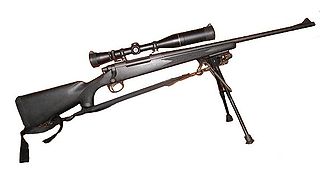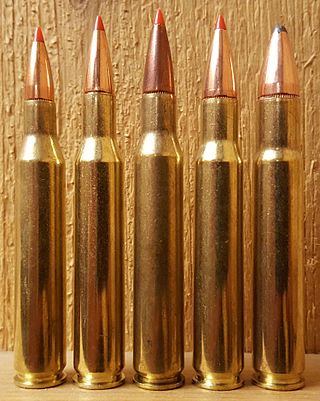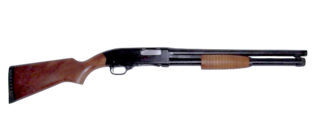Related Research Articles
Savage Arms is an American gunmaker based in Westfield, Massachusetts, with operations in Canada and China. Savage makes a variety of rimfire and centerfire rifles, as well as Stevens single-shot rifles and shotguns. The company is best known for the Model 99 lever-action rifle, no longer in production, and the .300 Savage. Savage was a subsidiary of Vista Outdoor until 2019 when it was spun off.

The Remington Model 700 is a series of bolt-action centerfire rifles manufactured by Remington Arms since 1962. It is a development of the Remington 721 and 722 series of rifles, which were introduced in 1948. The M24 and M40 military sniper rifles, used by the United States Army and United States Marine Corps, respectively, are both based on the Model 700 design.

The .270 Winchester is a rifle cartridge developed by Winchester Repeating Arms Company in 1923, and it was unveiled in 1925 as a chambering for their bolt-action Model 54 to become arguably the flattest shooting cartridge of its day, only competing with the .300 Holland & Holland Magnum, also introduced in the same year.

The M1917 Enfield, the "American Enfield", formally named "United States Rifle, cal .30, Model of 1917" is an American modification and production of the .303-inch Pattern 1914 Enfield (P14) rifle, which was developed and manufactured during the period 1917–1918. Numerically, it was the main rifle used by the American Expeditionary Forces in Europe during World War I. The Danish Sirius Dog Sled Patrol in Greenland still use the M1917, which performs reliably in Arctic conditions, as their service weapon.
The Savage 10FP is a bolt-action sniper rifle manufactured by Savage Arms and based on the Savage Model 110 rifle. There are seven variants of this rifle, each designated with an "LE" code signifying that it is part of the Law Enforcement Series. Most 10FP series rifles are configured with the AccuTrigger, matte-blued barreled action, heavy free-floating and button-rifled barrel, oversized bolt handle, internal box magazine, and three swivel studs for sling and bipod mounting.
The Savage Model 99, Model 1899, and their predecessor the model 1895 are a series of hammerless lever action rifles created by the Savage Arms Company in Utica, New York. The Model 99 family featured a unique rotary magazine, and later added some detachable magazine models. The rifle was extremely popular with big game hunters and was even issued to the Montreal Home Guard during the First World War.

The Model 1200 is a pump-action shotgun that was manufactured by the Winchester-Western Division of Olin Corporation, starting 1964. It was redesignated the Model 1300 in 1978 with minimal changes. Production ceased in 2006 when the U.S. Repeating Arms Company, the subsequent manufacturer, went bankrupt. A militarized version of the Model 1200 was acquired by the U.S. Army for use during the Vietnam War. It is still in active service within various conflicts throughout the 21st century.
The Savage Model 110 is a bolt-action repeating rifle made by Savage Arms. It was designed in 1958 by Nicholas L. Brewer. It was patented in 1963 and has been in continuous production since that time. The model variants included the first left-handed rifle to be made "in volume" by a major firearms manufacturer.
The Remington Model 798 is a bolt-action rifle that was sold by Remington Arms from 2006 until 2008. The gun was made as a hunting rifle. It is composed of an imported Zastava Arms barreled action assembled with a laminated stock after import to the United States. It is based on a Mauser 98 action. It is chambered for .243 Winchester, .308 Winchester, .30-06 Springfield, .270 Winchester, 7mm Remington.Magnum, .300 Winchester.Magnum, .375 H&H Magnum and .458 Winchester Magnum It is drilled and tapped for scope mounts. It can have a barrel length of 22, 24 or 26 inches. It weighs 7 pounds, and has a brown laminated stock. The standard variant costs $599, and the Magnum versions can cost anything between $638 and $839. This is an all-steel, controlled-feed action using a flat-bottom receiver with an integral recoil lug, one-piece bolt with dual locking lugs plus a third safety lug and a bolt guide, full-length extractor, solid steel one-piece bottom iron/magazine box/trigger guard, hinged magazine floor plate, and all of the usual Mauser 98 deluxe features.
The Remington Model 30 is a US sporting rifle of the inter-war period based on the military P14/M1917 Enfield rifle action, which was manufactured for the British and US governments during World War I. Initial specimens used surplus military parts with some modifications in order to consume the stock of parts, though further modifications were made as production progressed and later rifles were produced from newly manufactured parts. Most early rifles were in the military .30-06 calibre used in the M1917 but it became available in a variety of chamberings. It was the first high-powered bolt-action sporting rifle produced by Remington. Some would beg to differ as Remington made the Remington Lee factory sporting rifle from 1899-1909, 1446 were built in a variety of calibers.
The Winchester Model 52 was a bolt-action .22-caliber target rifle introduced by the Winchester Repeating Arms Company in 1920. For many years it was the premier smallbore match rifle in the United States, if not the world. Known as the "King of the .22s," the Model 52 Sporter was ranked by Field & Stream as one of "the 50 best guns ever made" and described by Winchester historian Herbert Houze as "perfection in design." However, by the 1970s the World War I-era design was showing its age and had given way in top-level competition to newer match rifles from Walther and Anschütz; the costly-to-produce Model 52, which had long been a loss leader prestige product by that time, was finally discontinued when US Repeating Arms took over the manufacture of Winchester rifles from Olin Corporation in 1980.
The CZ-550 is a bolt-action hunting rifle series manufactured by Česká zbrojovka Uherský Brod. The CZ 550 series is available with a medium or magnum sized action. The CZ 550 rifle is based on the Mauser 98 rifle.
The Mauser Model 1893 is a bolt-action rifle commonly referred to as the Spanish Mauser, though the model was adopted by other countries in other calibers, most notably the Ottoman Empire. The M1893 was based on the experimental M1892 rifle, which Paul Mauser developed for the Spanish Army as part of a program to correct deficiencies in the earlier 1889, 1890, and 1891 series of Mauser rifles. The M1893 introduced a short staggered-column box magazine that fit flush with the bottom of the stock; the magazine held five smokeless 7×57mm Mauser rounds, which could be reloaded quickly by pushing a stripper clip from the top of the open bolt.
The Howa 1500 or Howa M1500 is a bolt-action rifle produced in Japan by Howa Machinery. Introduced in 1979, it has been used by hunters as a hunting rifle with various cartridge offerings. It is also utilized by military and law enforcement elements as a sniper rifle. It is sold under the name of Howa Model 1500 Rifle for overseas markets.
The Savage 110 BA is a bolt-action sniper/tactical rifle manufactured by Savage Arms. The rifle is designated with an "LE" code; "Law Enforcement". All 110 BA series rifles are configured with AccuTrigger, matte-blued barreled action, fluted heavy free-floating barrel, muzzle brake, oversized bolt handle, external box magazine, magpul adjustable stock, adjustable pistol grip, and three swivel studs for sling and bipod mounting.
The Ruger American Rifle is a family of budget-level hunting/sporting bolt-action centerfire rifle made by Sturm, Ruger & Co., which also produces a line of rimfire rifles with similar designs called the Ruger American Rimfire.
The BSA CF2 is a rifle manufactured by the Birmingham Small Arms Company (BSA).
The Model 721 and Model 722 along with the later Model 725 variant are bolt-action sporting rifles manufactured by Remington Arms from 1948 until 1961. The 721/722 replaced the short-lived Model 720. The Model 721/722 is considered to be one of the first modern, economically produced sporting rifles whose design largely continued with the subsequent and highly successful Model 700. Manufactured with high precision, it is known for exceptional accuracy. The bolt and receiver design, based on the Mauser action, is considered one of the strongest ever produced. Samples in excellent condition have become collectible.
The Stevens Model 520 was a pump-action shotgun developed by John Browning and originally manufactured by the J Stevens Arms & Tool Company between 1909 and 1916. Stevens was sold to New England Westinghouse on 28 May 1915 and production of civilian firearms was greatly reduced. The company was renamed the "J Stevens Arms Company" on 1 July 1916 and New England Westinghouse used their manufacturing facility in Chicopee Falls, MA to produce Mosin-Nagant rifles under contract for the Russian Czar during World War I. After the war, Stevens was sold to Savage Arms on 1 April 1920 and full production of civilian firearms resumed. Under Savage ownership, Model 520 production continued until 1939 when it was replaced by the Model 520A which ended production in 1948. Stevens also further modified the design when they introduced the streamlined Model 620 in 1927. The Model 620 was internally similar to the Model 520 and was produced until 1939 when it was replaced by the Model 620A which ended production in 1955. This shotgun is a hammerless, pump action, take-down design with a tubular magazine which holds 5 shells. All models can also be slam fired: the shotgun has no trigger disconnector and shells can be fired one after the other simply by working the slide if the trigger is held down.
The Heym SR 30 is a straight-pull rifle produced in Germany by Heym. The rifle is also available in a left hand version.
References
- ↑ Anderson, Dave (23 May 2022). "Savage 1920 Rifle: A Rifle Ahead Of It's Time". gunsmagazine.com.
- ↑ Savage Model 1920 - Baby Springfield
- ↑ Simpson, Layne (30 January 2023). "Savage Model 1920: The First Lightweight Mountain Rifle". RifleShooter. Retrieved January 30, 2023.
- ↑ "Savage Model 1920 300 Savage 24" Bolt Action Rifle 1920 C&R". 10 July 2024.